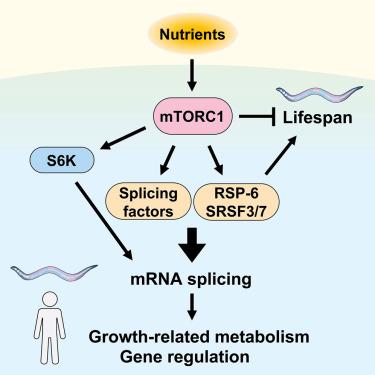营养物质通过 mTORC1 对 mRNA 剪接的调控控制生长和新陈代谢
IF 14.5
1区 生物学
Q1 BIOCHEMISTRY & MOLECULAR BIOLOGY
引用次数: 0
摘要
细胞生长和生物体发育是非常复杂的过程,需要雷帕霉素复合体 1(mTORC1)的营养响应激酶机制靶标。考虑到 mTORC1 的重要功能仍有待确定,我们在秀丽隐杆线虫中采用了遗传和生物信息学筛选方法来揭示 mTORC1 的作用机制。在这里,我们发现在幼虫生长过程中,营养物质通过mTORC1的作用诱导基因表达和mRNA剪接的广泛重编程。mTORC1通过增加丝氨酸/精氨酸丰富(SR)蛋白RSP-6(SRSF3/7)和其他剪接因子的活性,在很大程度上独立于其目标p70 S6激酶(S6K)来调节mRNA剪接和编码蛋白的mRNA异构体的产生。mTORC1 介导的 mRNA 剪接调控对生长至关重要;介导包括能量、核苷酸、氨基酸和其他代谢途径在内的营养控制机制;并且可能在人类中保守。虽然抑制 mTORC1 会延缓衰老,但 mTORC1 诱导的 mRNA 剪接会促进长寿,这表明当 mTORC1 受到抑制时,加强这种剪接可能会带来额外的抗衰老益处。本文章由计算机程序翻译,如有差异,请以英文原文为准。

Nutrient control of growth and metabolism through mTORC1 regulation of mRNA splicing
Cellular growth and organismal development are remarkably complex processes that require the nutrient-responsive kinase mechanistic target of rapamycin complex 1 (mTORC1). Anticipating that important mTORC1 functions remained to be identified, we employed genetic and bioinformatic screening in C. elegans to uncover mechanisms of mTORC1 action. Here, we show that during larval growth, nutrients induce an extensive reprogramming of gene expression and alternative mRNA splicing by acting through mTORC1. mTORC1 regulates mRNA splicing and the production of protein-coding mRNA isoforms largely independently of its target p70 S6 kinase (S6K) by increasing the activity of the serine/arginine-rich (SR) protein RSP-6 (SRSF3/7) and other splicing factors. mTORC1-mediated mRNA splicing regulation is critical for growth; mediates nutrient control of mechanisms that include energy, nucleotide, amino acid, and other metabolic pathways; and may be conserved in humans. Although mTORC1 inhibition delays aging, mTORC1-induced mRNA splicing promotes longevity, suggesting that when mTORC1 is inhibited, enhancement of this splicing might provide additional anti-aging benefits.
求助全文
通过发布文献求助,成功后即可免费获取论文全文。
去求助
来源期刊

Molecular Cell
生物-生化与分子生物学
CiteScore
26.00
自引率
3.80%
发文量
389
审稿时长
1 months
期刊介绍:
Molecular Cell is a companion to Cell, the leading journal of biology and the highest-impact journal in the world. Launched in December 1997 and published monthly. Molecular Cell is dedicated to publishing cutting-edge research in molecular biology, focusing on fundamental cellular processes. The journal encompasses a wide range of topics, including DNA replication, recombination, and repair; Chromatin biology and genome organization; Transcription; RNA processing and decay; Non-coding RNA function; Translation; Protein folding, modification, and quality control; Signal transduction pathways; Cell cycle and checkpoints; Cell death; Autophagy; Metabolism.
 求助内容:
求助内容: 应助结果提醒方式:
应助结果提醒方式:


